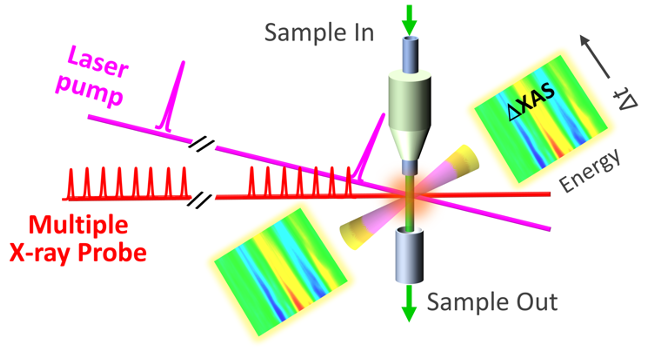
Scientists who work on the production of renewable energy want to understand the photochemical processes involved in activity such as the photocatalytic production of hydrogen or the conversion of carbon dioxide into various hydrocarbons. The difficulty lies in the dynamic nature of the process; while it is straightforward to see the products going into and coming out of photocatalysis, there are a lot of unstable intermediate species that form along the way but only last tens of nanoseconds or less.
Identifying and understanding these intermediate species, while experimentally challenging, is crucial for optimizing photocatalytic reactions for sustainable energy production. Now researchers using the Advanced Photon Source (APS), a U.S. Department of Energy (DOE) Office of Science user facility at DOE’s Argonne National Laboratory, have developed a technique to gather data at sufficiently short intervals to understand how the chemical process is evolving.
X-ray transient absorption (XTA) spectroscopy is an important tool for studying photochemical reactions. XTA spectroscopy uses a laser pump to initiate a photochemical reaction and X-ray pulses from a synchrotron to measure changes in the physical structure of a molecule in the sample as well as its oxidation state. Over the years, a team of Argonne researchers have developed a technique called X-ray Multiprobe Data Acquisition (XMP-DAQ). This technique can measure a large number of XTA spectra at different time delays in a single measurement. That significantly increases the experiment efficiency and allows users to detect much smaller changes at different delays.
The earlier version of XMP-DAQ has a temporal limitation. The time interval between two XTA spectra captured in one data acquisition is determined by the timing between the X-ray probe pulses delivered from synchrotron light sources, which is often larger than 10 nanoseconds. This limitation poses challenges in acquiring high-resolution measurements of photochemical reaction dynamics that occur faster than 10 nanoseconds.
The researchers have now come up with newer versions of data acquisition for XTA studies called high-repetition-rate XMP (HRR-XMP) and asynchronous XMP (AXMP). HRR-XMP increases the XTA measurement efficiency of faster dynamics by a factor of up to 200, which increases the sensitivity 15 times over what had previously been achieved. AXMP relies on the same high repetition rate for the lasers but combines it with a novel synchronization concept. AXMP can efficiently measure the high-resolution photochemical reaction dynamics down to sub-nanosecond time scales. An important and useful feature of AXMP is its flexibility in choosing the time delays of the XTA spectra set obtained in a single acquisition, tailored for the particular chemical reaction of interest.
The researchers performed their work at beamline 7-ID-D at the APS. That beamline includes the high-repetition rate laser they needed, as well as the system for delivering a jet of liquid containing the sample to be measured. To demonstrate the advantages of these new techniques, the team measured the photochemical reaction dynamics of two iron molecules. HRR-XMP was demonstrated by measuring ferrocyanide. The high-data quality obtained by HRR-XMP enabled a quantitative analysis of the reaction intermediates and their dynamics.
AXMP was demonstrated by measuring iron tris-bipyridine, which produces a short lived XTA signal of only ~660 picoseconds. In this case the researchers were interested in dynamics of this material in the first 1-2 nanoseconds after the laser pulse. Leveraging the flexibility of AXMP to increase the data collection efficiency in this time window, the team collected 9,700 measurements at intervals of 6.5 picoseconds in the first 1.4-nanosecond window, then at 1.4 nanosecond intervals thereafter.
HRR-XMP and AXMP are particularly suited for providing a comprehensive understanding of complex photochemical reactions, thanks to their efficient and flexible data acquisition capabilities. This scheme might be applied to some other pump and probe methods, potentially improving their performance. – Neil Savage
____________________________________________________________________________________
See: E. D. Kinigstein1,2, C. Otolski1, G. Jennings1, G. Doumy1, D. A. Walko1, X. Zuo1, J. Guo2, A. M. March1, X. Zhang1, “Asynchronous X-ray Multiprobe Data Acquisition for X-ray Transient Absorption Spectroscopy,” Rev. Sci. Instrum. 94, 014714 (2023)
Author affiliations: 1Argonne National Laboratory; 2Lawrence Berkeley National Laboratory.
The U.S. Department of Energy's APS at Argonne National Laboratory is one of the world’s most productive x-ray light source facilities. Each year, the APS provides high-brightness x-ray beams to a diverse community of more than 5,000 researchers in materials science, chemistry, condensed matter physics, the life and environmental sciences, and applied research. Researchers using the APS produce over 2,000 publications each year detailing impactful discoveries and solve more vital biological protein structures than users of any other x-ray light source research facility. APS x-rays are ideally suited for explorations of materials and biological structures; elemental distribution; chemical, magnetic, electronic states; and a wide range of technologically important engineering systems from batteries to fuel injector sprays, all of which are the foundations of our nation’s economic, technological, and physical well-being.
Argonne National Laboratory seeks solutions to pressing national problems in science and technology. The nation's first national laboratory, Argonne conducts leading-edge basic and applied scientific research in virtually every scientific discipline. Argonne researchers work closely with researchers from hundreds of companies, universities, and federal, state and municipal agencies to help them solve their specific problems, advance America's scientific leadership and prepare the nation for a better future. With employees from more than 60 nations, Argonne is managed by UChicago Argonne, LLC, for the U.S. DOE Office of Science.
The U.S. Department of Energy's Office of Science is the single largest supporter of basic research in the physical sciences in the United States and is working to address some of the most pressing challenges of our time. For more information, visit the Office of Science website.
